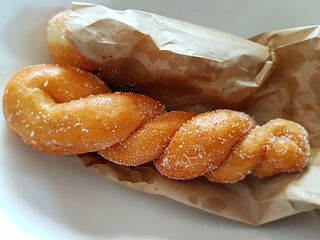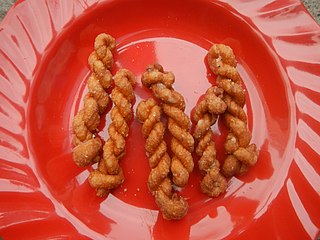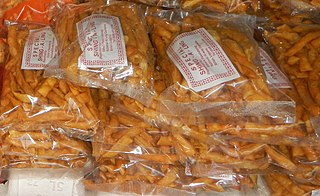Related Research Articles

A doughnut or donut is a type of pastry made from leavened fried dough. It is popular in many countries and is prepared in various forms as a sweet snack that can be homemade or purchased in bakeries, supermarkets, food stalls, and franchised specialty vendors. Doughnut is the traditional spelling, while donut is the simplified version; the terms are used interchangeably.

Funnel cake is a regional sweet food popular in North America, found mainly at carnivals and amusement parks. It is made by deep-frying batter.

Tocino is bacon in Spanish, typically made from the pork belly and often formed into cubes in Spain. In Caribbean countries, such as Puerto Rico and Cuba, tocino is made from pork fatback and is neither cured nor smoked but simply fried until very crunchy; it is then added to recipes, much like the way lardons are used in French cuisine. In the Philippines, tocino refers to sweetened and cured pork belly.

Sinangag, also called garlic fried rice or garlic rice, is a Filipino fried rice dish cooked by stir-frying pre-cooked rice with garlic. The rice used is preferably stale, usually leftover cooked rice from the previous day, as it results in rice that is slightly fermented and firmer. It is garnished with toasted garlic, rock salt, black pepper and sometimes chopped scallions. The rice grains are ideally loose and not stuck together.
Jaa can refer to the following:

Bagnet, also locally known as "chicharon" or tsitsaron in Ilocano, is a Filipino dish consisting of pork belly (liempo) boiled and deep fried until it is crispy. It is seasoned with garlic, black peppercorns, bay leaves, and salt. First, the meat is boiled, and, then allowed to thoroughly drain excess moisture overnight before frying, to achieve its characteristic chicharon-like texture. Bagnet can be eaten on its own or with white rice. It can also be used as an ingredient or paired with other dishes like pinakbet and dinardaraan.

Ampaw, ampao or arroz inflado, usually anglicized as pop rice or puffed rice, is a Filipino sweet puffed rice cake. It is traditionally made with sun-dried leftover cooked white rice that is fried and coated with syrup.

Shakoy, also known as lubid-lubid or bicho bicho, is a traditional Filipino deep-fried twisted doughnut. It is traditionally made with flour, sugar, salt, and yeast and deep-fried. It is then sprinkled with white sugar. Variants of shakoy can also be made with other kinds of flour, most notably with rice flour, which results in a chewier version that is also usually coated with sesame seeds. Dry and crunchy versions of shakoy, which are usually much smaller, are known as pilipit.

Lumpia are various types of spring rolls from China, Indonesia and the Philippines. Lumpia are made of thin paper-like or crepe-like pastry skin called "lumpia wrapper" enveloping savory or sweet fillings. It is often served as an appetizer or snack, and might be served deep-fried or fresh (unfried). Lumpia are Indonesian and Filipino adaptations of the Fujianese rùnbǐng and Teochew popiah, usually consumed during Qingming Festival.

Prawn crackers are a deep-fried snack made from starch and prawn. They are a common snack food in Southeast Asian cuisine, but they are most closely associated with Indonesia. They have also been adapted into East Asian cuisines, where the similar Japanese kappa ebisen (かっぱえびせん) and Korean saeukkang are popular snacks.
Lokot-lokot or Locot-locot is a delicacy common in Mindanao and the Sulu Archipelago in the Philippines. It is also referred to as jaa in Sulu; tagaktak, tinagtag, tinadtag, or tinagaktak in Maguindanao, and amik in Davao del Sur. Its texture is crunchy, usually colored golden-brown. Lokot-Lokot is usually produced and served on special occasions such as the Muslim feast of Eid al-Fitr.

Panyalam or panyam, is a traditional Filipino-Bangsamoro fried rice pancake. It is made with ground glutinous rice, muscovado, and coconut milk mixed into a batter that is deep-fried.

Kiping is a traditional Filipino leaf-shaped wafer made from glutinous rice. It originates from the city of Lucban, Quezon. It is celebrated annually in the Pahiyas Festival. It can be eaten grilled or fried and can be dipped in sugar, vinegar, or other sauces.

Kabkab, also known as cassava cracker or cassava crisp, is a traditional Filipino disc-shaped wafer made from ground cassava. It originates from the southern Philippines, but is most closely associated with the cuisine of Mindanao and the southern Visayas Islands.

Pilipit is a traditional Filipino deep-fried twisted doughnut. It is made with flour, eggs, milk, salt, and baking powder. It is made mostly identically to the shakoy doughnut, except for its crunchy and hard texture and its smaller and thinner size. The word pilipit means "twisted" in Tagalog.

Cornick is a Filipino deep-fried crunchy puffed corn nut snack. It is most commonly garlic-flavored but can also come in a variety of other flavors. It is traditionally made with glutinous corn.

Shing-a-ling is a Filipino snack made from dried thick egg noodles locally known as pancit miki that is deep-fried and dusted with garlic, chili, and beef powder. It can also be eaten as is with a vinegar-based dip, or dusted in sugar. Some commercial versions directly fry wheat dough. It has a distinctive shape that resembles green beans.

Silog is a class of Filipino breakfast dishes containing sinangag and itlog. They are served with various viands or ulam, often fried as well, and usually meat dishes such as tapa, longganisa or ham. The name of the accompanying meat dish determines the portmanteau name of the silog; for example, the former three would be known as tapsilog, longsilog, and hamsilog.
Daral, also known as darar, is a Filipino dessert crêpe rolled into a cylinder and filled with sweetened coconut meat (hinti). It originates from the Tausug people of the Philippines. It is also known as balolon among the Maranao people. The crêpe wrapper is similar to the lumpia wrapper, except that it uses batter made from unsweetened ground glutinous rice with coconut milk (galapong). The wrap is sometimes flavored with pandan leaves. However, modern versions can use flour.
References
- ↑ "Ramadan 2013 Celebration in ARMM". PinasMuna.com. Retrieved March 26, 2019.
- ↑ "Kumukunsi". ChoosePhilippines. Archived from the original on June 29, 2021. Retrieved March 26, 2019.
- ↑ Salvador, Jinggoy I. (July 28, 2015). "My love affair with Putri Mandi". SunStar Davao. Retrieved March 26, 2019.

